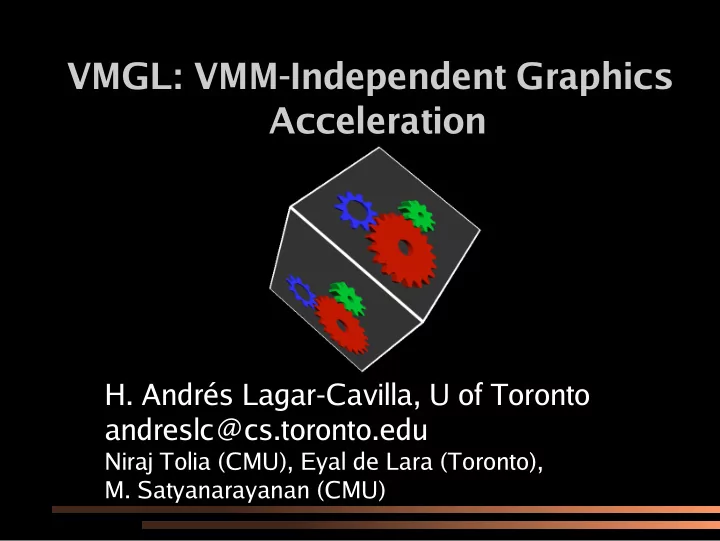

VMGL: VMM-Independent Graphics Acceleration H. Andrés Lagar-Cavilla, U of Toronto andreslc@cs.toronto.edu Niraj Tolia (CMU), Eyal de Lara (Toronto), M. Satyanarayanan (CMU)
Why Virtualize 3D Acceleration? Two simultaneous trends VMs out of the server room Client apps going 3D ●
Virtualization of Client Apps Soulpads The Collective Internet Suspend/Resume Virtual Appliances Moka5
The World Is Going 3D
Why Is 3D Virtualization Hard? 3D vendors compete through HW diversity Lack of unifying hardware abstraction Closed specs Open HW abstractions simplify virtualization: Network -> Ethernet Frame Block Devices -> BIO request SCSI drives -> SCSI command packet .... How could we ever write 3D applications?
3D Rendering APIs De facto unifying sotware abstraction Developer gets vendor independence Two main APIs OpenGL Direct3D OpenGL Cross-platform
VMGL: Virtualizing OpenGL Provides 3D HW acceleration to applications running inside virtual machines GPU independent VMM independent Guest OS independent 87% or better of native HW acceleration Two orders of magnitude better than Mesa
VMGL Design API virtualization GPU vendor independence OpenGL: cross-platform API Guest OS independence Network Communication VMM independence
OpenGL Apps In X11 Systems Application Vendor X Server Open GL 3D 2D GPU
VMGL Apps in X11 Guest VMs VM Viewer: VNC, SDL Application VMGL Stub X Server VMGL GL Vendor Commands Open GL Guest Host: Dom 0 GPU
Implementation Aspects Efficient GL network transport 3D and 2D output composing in VM viewer Suspend/Resume implementation Dom0 drivers
Efficient GL Transport Transport over network VMM Independence WireGL / Chromium Only send updates that “matter” glTextureXY only when texture visible Combine, reorder and buffer commands glRotate + glTranslate -> Single matrix transformation
Window Manager Extension Compose 3D and 2D output on VM viewer Extension in VM's X server tells viewer 3D output Position Size Clipping
Suspend / Resume Think each GL app as a GL device Runtime: keep track of OpenGL state Suspend: “freeze” G L device (trivial) Resume: flush state to new GL stub OpenGL state is GPU independent Suspend/resume across different GPUs OpenGL state is bounded Upper bound: GPU mem size
VMGL Suspend / Resume State Windows Visual bits Binding to window manager extension GL Contexts Context data: fog, transformations... Textures: pixmap, clamp mode Display Lists: verbatim unrolling
Domain 0 GPU Drivers ATI & Nvidia: GPU Mem mapping in user-space GL lib Oblivious to Xen additional indirection Virtual -> Physical (VM) -> Machine Even for domain 0 Fix open source portion of driver Use Xen-paravirt mem mapping functions
VMGL Evaluation VMGL: OpenGL Virtualization API v1.5 Shaders through extensions Frames per second CPU, bandwidth consumption Resume latency, state size Workloads Games & entertainment fuel 3D industry
Workloads Quake 3 Enemy Territory Mplayer Unreal 2004
Performance (FPS) 90 80 70 60 Native 50 40 30 20 10 0 Quake 3 Enemy Unreal Mplayer
Performance (FPS) 90 80 70 60 Native 50 Mesa 40 30 20 10 0 Quake 3 Enemy Unreal Mplayer
Performance (FPS) 90 80 70 60 Native 50 Mesa 40 VMGL 30 20 10 0 Quake 3 Enemy Unreal Mplayer 87% or better of native performance
VMM Portability (FPS) 90 80 70 60 Xen HVM 50 VMware 40 Xen PV-HVM 30 Xen PV 20 10 0 Quake 3 Enemy Unreal Mplayer VMM and VM type independent
Guest OS Portability (FPS) 90 80 70 60 50 Mesa 40 VMGL 30 20 10 0 FreeBSD Open Solaris Linux Easily ported to other X11-based OSs
Suspend Resume Performance State Size(MBs) Resume Time (ms) 80 2500 70 2000 60 50 1500 40 1000 30 20 500 10 0 0 Quake 3 Quake 3 Enemy Enemy Unreal Unreal Mplayer Mplayer State size bounded Also across GPUs from different vendors
Wrapping Up VMGL: OpenGL virtualization -> 1K downloads Enable intersection of two growing trends Virtualization 3D Graphics GPU/vendor independence VMM independence Guest OS independence To appear @ VEE 2007 More eval & details there
TODO Xen-specific improvements Shared memory transport (XenSocket?) Windows Code porting Window Manager hooks Direct3D support via translation layers
THANKS Demo Q&A andreslc@cs.toronto.edu www.cs.toronto.edu/~andreslc/vmgl/
Recommend
More recommend